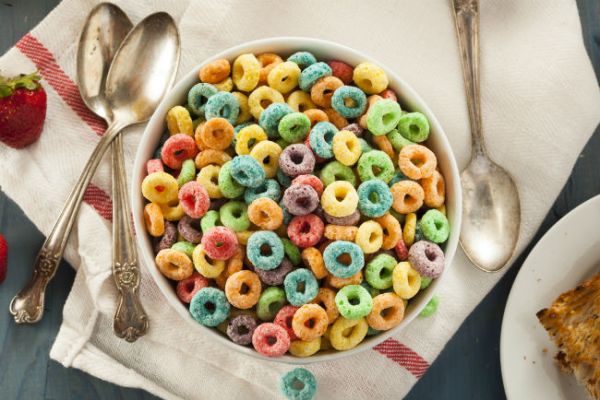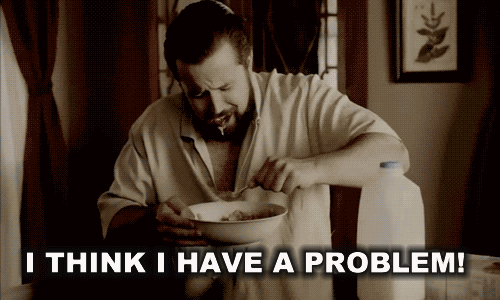
Today is National Cereal Day. Yes, even cereal — the bane of lazy millennials everywhere — has its own national holiday. And deservedly so! Because without cereal, we would all be a bunch of constipated, meat-eating heathens. We’ve come a long way, baby. So, pull up a stool, pour yourself a big bowl of generic Sugar Snappers, and let me tell you about the history of breakfast cereal in the U.S.
Our story begins in the 1860s. Back then, Americans were not the healthiest people ever. They consumed a lot of meat, a lot of alcohol, and a lot of coffee. Pooping was at an all time low—which Christian fundamentalists of the day believed was punishment from God for excessive meat consumption. (They also believed it fueled lust and laziness…take that, you Paleo nutters!) James Caleb Jackson, former abolitionist and advocate for all things hydropathy, bought into this idea, and, in 1863, invented his solution, Granula. And with that, cold breakfast cereal was born.
Granula wasn’t the most exciting thing to grace American breakfast tables, though. Made of baked graham flour dough crushed into nuggets (think larger, tougher Grape-Nuts), it was so rock hard that it had to be soaked in milk overnight to even be edible.
John Kellogg—yes, that Kellogg—caught on to Jackson’s idea and started serving his version of cereal at his hugely popular sanitarium up in Battle Creek, Michigan. After some copyright infringement issues, he changed the name of it to Granola. He and his brosky W.K. also tinkered with the formula a bit, accidentally coming up with the flake version of granola, Corn Flakes, after six years of experimentation. Cue cereal’s second major milestone.
The thing about cereal flakes is that they’re manufacturing perfection. They’re super easy to produce, and they carry huge profit margins—up to 50% to this day. Which was attractive to one Charles Post, failed suspender salesman and advertising genius. C.W., as he was called, took Kellogg’s cereals and produced knock-off versions of his own, promoting his cereal in pamphlets with titles such as “The Road to Wellsville” as having the ability to cure appendicitis, make red blood redder, and even raise IQ. People bought into the hype, making C.W. a very rich man: by 1903, he was clearing a million a year, and Battle Creek, Michigan was officially becoming the cereal capital of the world.
Post’s success, as well as W.K. Kellogg’s departure from his brother to get into the cereal marketing business himself, officially ushered in the 20th century cereal boom. By 1911, 107 brands of corn flakes were being produced in Battle Creek.
Which was a whole lot of options for a bunch of corn flakes variants that tasted the same. Manufacturers realized that they had to distinguish their cereal another way. Enter cereal box branding, cereal’s third milestone. Some companies chose to advertise themselves by cramming a bunch of cool-sounding adjectives on the box: “University Brand Daintily Crisped Flaked Corn.” Others tried to set themselves apart by advertising their unique spin on corn flakes, such as Tryabita, which was “thrice baked and thoroughly impregnated with pepsin and celery.” Yum.
The best thing that came of the new wave of cereal-box marketing was Force Cereal’s Sunny Jim. The (presumably) once-constipated cartoon character who was transformed into a quick-striding gentleman by eating Force was the cereal game’s first mascot. Other producers rushed to copy the ways of the Force, er…of Force.
Soon enough, cereal companies—now entirely removed from their God and constipation-fearing fundamentalist Christian beginnings—realized that radio programs and children were the future. In 1936, a character named Skippy arrived, extolling the virtue of Wheaties in the midst of his broadcast adventures. Kids, suckers that they are, ate him up, and with that, other cereal companies followed suit. By the time the 60s rolled around, 90% of cereal advertising budgets went directly toward marketing to children.
Enter sugar, cereal’s final innovation. Because do kids love tasteless wheat-flake cereal? Heck no. The brighter, the sweeter the better. Cereal manufacturers touted the health benefits of their newly-sugared cereal, saying that it gave kids and adults alike the fuel they needed to start their days out right. And with that, James Caleb Jackson turned over in his grave and wept.

These days, just about everyone above the age of puberty is keen to cereal advertising tactics. Yeah, it’s sweet, yeah, it’s empty calories, but that doesn’t keep us from going back to our Cap’n Crunch or Count Chocula. Sugary cereal is comfort. We eat it with milk, or just grab it by the handful from the box. Or heck, sometimes we just pour it directly into our mouths for the fun of it. Cereal might not be saving us from the wrath of God anymore, but it certainly isn’t going anywhere anytime soon.






